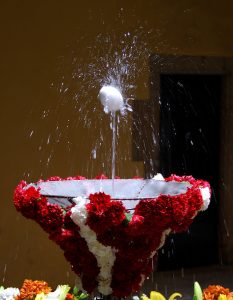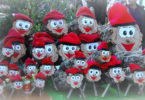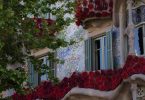Catalonia is a fascinating region of Spain, with a strong, patriotic people, a rich history, and a colorful culture. In this article, ShBarcelona will introduce you to some of the most interesting Catalan traditions.
Table of Contents
L’ou com balla



Photo by tetegil via Visualhunt
L’ou com balla or The dancing egg is a very particular tradition which takes place in a number of cities of Catalonia during Corpus Christi, a Christian rite that happens the Thursday after Trinity Sunday, 60 days after Easter, celebrating the belief in the body and blood of Jesus Christ’s Real Presence in the Eucharist. In Catalonia, an egg is placed on top of a jet shooting out of a water fountain, which makes the egg keep rotating, which gives the impression that it is dancing. The egg is previously emptied and the hole is covered with wax, stopping it from being filled with water while on the fountain. The fountains used for this are usually adorned with beautiful flowers and sometimes even fresh fruit. If you want to see l’ou com balla, make sure to visit Barcelona at the appropriate time of year and to find and to get to Santa Eulalia’s Cathedral early, to find a good spot among the crowd.
The Festes Majors
Catalans love celebrations and the Festes Majors are some of the most popular ones among locals and tourists. Festa Major, which translates to “Big Party”, refers to what is usually a week-long celebration that takes place in a neighborhood, with a number of concerts, attractions, and food stalls. There are many Festes Majors that take place across the city but most famous one is the Festa Major de Gràcia, which happens in the month of August. The neighbors work hard on the preparations, and each street gets decorated with a different theme, some with quite spectacular results.
The castellers
Another impressive demonstration that can usually be spotted during the major celebrations in Catalonia is the building of a castell. Basically, a castell is a human tower, which is formed by a large group of people called the castellers. There is usually a large base, formed by the strongest individuals, then a large tower is built on top of that, and a child will climb it all the way to the top. There are various castellers groups in Catalonia, each with its own colors, but all of them use the traditional casteller uniform, which includes pants and a shirt and the most important part of it, a strap that is tightly wrapped around their waists, which other castellers will use to climb.
Related article: Bank holidays in Barcelona
The correfocs



Photo by VRoig via Visualhunt
The correfocs aren’t exclusive to Catalonia but they are a very prominent part of traditional Catalan celebrations. A group of people get dressed up in devil costumes and run around with pitchforks that are rigged with fireworks. They are usually followed by a beast-like effigy which spits fire, all of this to the sound of music. It is common to find correfocs displays in big celebrations like the Festes Majors and La Mercè.
The Sardana
If you have visited Barcelona before, you may have already stumbled upon a group of people gathered around in the circle, hand in hand, moving back and forth in a rhythmic motion. If that was the case, you were probably witnessing the dancing of the Sardana. The dance is usually performed to the sound of a number of wind instruments, double bass and a small drum, with the music usually being played by a band of 11 members. Holding hands and with their arms raised high, the dancers perform a number of leg and foot movements that are usually dictated by a leader.
Gigantes y Cabezudos
Another tradition that is not exclusive to Catalonia but which is an essential part of a lot of the Catalan celebrations is that of the gigantes and the cabezudos, or “giants” and “big heads”.
The giants, as the name indicates, are large figures usually representing kings, queens, bourgeois people, peasants and other relevant historical characters. These figures, which are usually made of papier-mâché, wood and aluminum, are big enough so that a person can stand inside them and make them move around and dance.
The cabezudos, on the other hand, are usually short characters, with very big heads. In this case, only the head is build out of papier-mâché, which people use in combination with a costume. While the gigantes are usually good-looking figures, the cabezudos usually have exaggerated features for comical effect.
Related article: Biggest celebrations in Barcelona
Christmas traditions



Photo by Barcelona.cat via Visualhunt
If you visit Barcelona during the winter, before Christmas time, you will undoubtedly run into one of the city’s Christmas markets. The most famous Christmas market in the city is the Fira de Santa Llúcia, which usually takes place in front of Santa Eulalia’s Cathedral, at Plaza Nova, in the Gothic neighborhood. This the perfect place for you to find two of the most interesting and amusing characters in Catalan tradition: the Tió de Nadal and the Caganer. Both of these little fellows play an important part in traditional Catalan Christmas celebrations, both bringing gifts of sorts.
The Tió de Nadal, known by foreigners as Christmas Log or Caga Tió is, as the English name indicates, a log that is decorated with a smiling face, a pair of tiny legs and a traditional Catalan hat. This friendly-looking fellow enters families’ houses in the beginning of December, particularly houses that have children in it. The parents teach the kids to feed the Tió, leaving them fruit and other food items that are mysteriously gone in the morning. Some families cover the log with a small blanket to help make it comfortable. Christmas Eve is the Tió‘s big night, when it is brought to a common area so that the children can sing the Caga Tió song, while hitting the log with sticks. In the song, the children tell the log to poop gifts for them, like nougat, hazelnuts, and cheese, if he wants to prevent being hit any further with the sticks. When the song ends, the children run out of the room and the parents sneak small gifts under the Tió‘s blanket. Some families keep their logs for the next couple of Christmases, while others, in a bizarre twist, end up throwing the log into the fireplace.
The Caganer is another little fellow that makes the Catalan Christmas so interesting. The Caganer, whose name translates literally as “shitter”, is a small ceramic figurine of a man, dressed in traditional clothing, complete with a red hat, who happily squats over his newly produced poop. And what role does this happy fellow play on the Catalan Christmas? The role of prosperity-bringer. The Caganer is placed in the Nativity Scene, together with Joseph, Mary and baby Jesus, except that this Catalan fellow is usually hidden behind bushes or some other place where his presence is not too obvious so that the children can have fun looking for it. It is said that the Caganer brings prosperity because it fertilizes the fields and that those who do not add a Caganer to their Nativity scene will not enjoy that great of a year.
Looking for an apartment in the city? ShBarcelona is the answer.
* Main photo by Amaianos via Visualhunt





















Catalonia is not a “region”, it’s a country, and we’ve got our own language. And please, don’t be so stupid and make us a favour, don’t say ever “gigantes” or “cabezudos”. It doesn’t exist, they are gegants i capgrossos. Will you also translate “spaguetti”? Tourists you’re not welcome as misunderstanding our culture like a folkcloric product. Terrible.